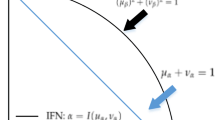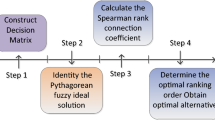Abstract
This paper proposes a new order relation for Pythagorean fuzzy numbers (PFNs) and applies to multi-attribute group decision making (MAGDM). The main contributions are outlined as five aspects: (1) the concepts of relative distance and information reliability of PFN are proposed. Then, a new order relation is developed to compare PFNs. Moreover, the new order relation of PFNs is demonstrated to be an admissible order. (2) Knowledge measure of PFN is defined to describe the amount of information. The desirable properties of knowledge measure of PFN are studied concretely. (3) For MAGDM with PFNs, the comprehensive distance between individual Pythagorean fuzzy matrices and a mean one are defined. Then, the decision makers’ weights are obtained by the comprehensive distances. Thus, a collective Pythagorean fuzzy matrix is derived by using the Pythagorean fuzzy weighted average operator. (4) To determine attribute weights, a multi-objective programming model is constructed by maximizing the overall knowledge measure of each alternative. This model is further transformed into a single-objective mathematical program to resolve. (5) According to the defined new order relation of PFNs, the ranking order of alternatives is generated by the comprehensive values of alternatives. Therefore, a new method is proposed to solve MAGDM with PFNs. Finally, an example of venture capital investment selection is provided to illustrate the effectiveness of the proposed method.





Similar content being viewed by others
References
Atanassov K (1986) Intuitionistic fuzzy sets. Fuzzy Set Syst 20(1):87–96
Atanassov K (1999) Intuitionistic fuzzy sets: theory and applications. Physica-Verlag, Heidelberg
Afful-Dadzie E, Afful-Dadzie A, Oplatková ZK (2017) Assessing commercial viability of technology start-up businesses in a government venture capital under intuitionistic fuzzy environment. Int J Fuzzy Syst 19(2):400–413
Aouni B, Colapinto C, La Torre D (2014) A fuzzy goal programming model for venture capital investment decision making. INFOR 52(3):138–146
Afful-Dadzie E, Afful-Dadzie A (2015) A decision making model for selecting start-up businesses in a government venture capital scheme. Manag Decis 54:714–734
Bustince H, Barrenechea E, Pagola M et al (2016) A historical account of types of fuzzy sets and their relationships. IEEE T Fuzzy Syst 24(1):179–194
Bustince H, Fernandez J, Kolesárová A et al (2013) Generation of linear orders for intervals by means of aggregation functions. Fuzzy Set Syst 220:69–77
Chen T (2018) Remoteness index-based Pythagorean fuzzy VIKOR methods with a generalized distance measure for multiple criteria decision analysis. Inf Fusion 41:129–150
Chen S, Cheng S, Lan T (2016) Multi-criteria decision making based on the TOPSIS method and similarity measures between intuitionistic fuzzy values. Inf Sci 367–368:279–295
Cheng X, Gu J, Xu Z (2018) Venture capital group decision-making with interaction under probabilistic linguistic environment. Knowl-Based Syst 140:82–91
Dong J, Wan S (2016) Virtual enterprise partner selection integrating LINMAP and TOPSIS. J Oper Res Soc 67(10):1288–1308
Gao H (2018) Pythagorean fuzzy Hamacher prioritized aggregation operators in multiple attribute decision making. J Intell Fuzzy Syst 35:2229–2245
Garg H, Kumar K (2018) A novel exponential distance and its based TOPSIS method for interval-valued intuitionistic fuzzy sets using connection number of SPA theory. Artif Intell Rev. https://doi.org/10.1007/s10462-018-9668-5
Garg H (2018) Hesitant Pythagorean fuzzy Maclaurin symmetric mean operators and its applications to multi-attribute decision making process. Int J Intell Syst. https://doi.org/10.1002/int.22067
Garg H (2016) A novel accuracy function under interval-valued Pythagorean fuzzy environment for solving multicriteria decision making problem. J Intell Fuzzy Syst 31(1):529–540
Garg H (2016) A new generalized Pythagorean fuzzy information aggregation using Einstein operations and its application to decision making. Int J Intell Syst 31(9):886–920
Garg H (2017) Generalized Pythagorean fuzzy geometric aggregation operators using Einstein t-norm and t-conorm for multicriteria decision-making process. Int J Intell Syst. https://doi.org/10.1002/int.21860
Garg H (2018) A linear programming method based on an improved score function for interval-valued Pythagorean fuzzy numbers and its application to decision-making. Int J Uncertain Fuzz 26(1):67–80
Garg H (2016) A new generalized improved score function of interval-valued intuitionistic fuzzy sets and applications in expert systems. Appl Soft Comput 38(5):988–999
Garg H (2017) A novel improved accuracy function for interval valued Pythagorean fuzzy sets and its applications in the decision-making process. Int J Intell Syst. https://doi.org/10.1002/int.21898
Garg H (2017) Confidence levels based Pythagorean fuzzy aggregation operators and its application to decision-making process. Comput Math Organ Theory 23:546–571. https://doi.org/10.1007/s10588-017-9242-8
Garg H (2017) Novel intuitionistic fuzzy decision making method based on an improved operation laws and its application. Eng Appl Artif Intell 60:164–174
Garg H (2018) Some methods for strategic decision-making problems with immediate probabilities in Pythagorean fuzzy environment. Int J Intell Syst 33(4):687–712
Garg H (2018) Generalized Pythagorean fuzzy geometric interactive aggregation operators using Einstein operations and their application to decision making. J Exp Theor Artif Intell 30(6):763–794
Garg H (2016) A novel correlation coefficients between Pythagorean fuzzy sets and its applications to decision-making processes. Int J Intell Syst 31(12):1234–1253
Khaista R, Saleem A, Rehan A et al (2017) Pythagorean fuzzy Einstein weighted geometric aggregation operator and their application to multiple attribute group decision making. J Intell Fuzzy Syst 33:635–647
Liang D, Xu Z, Liu D et al (2018) Method for three-way decisions using ideal TOPSIS solutions at Pythagorean fuzzy information. Inf Sci 435:282–295
Li Z, Wei G, Mao L (2018) Pythagorean fuzzy Hamy mean operators in multiple attribute group decision making and their application to supplier selection. Symmetry. https://doi.org/10.3390/sym10100505
Luis P, Luis Alberto P, Alejandro A et al (2018) MOORA under Pythagorean fuzzy set for multiple criteria decision making. Complexity. https://doi.org/10.1155/2018/2602376
Ma Z, Xu Z (2016) Symmetric Pythagorean fuzzy weighted Geometric/Averaging operators and their application in multi-criteria decision-making problems. Int J Intell Syst 12:1198–1219
Peng X, Dai J (2017) Approaches to Pythagorean fuzzy stochastic multi-criteria decision making based on prospect theory and regret theory with new distance measure and score function. Int J Intell Syst 32(11):1–28. https://doi.org/10.1002/int.21896
Peng X, Yang Y (2015) Some results for Pythagorean fuzzy sets. Int J Intell Syst 30(11):1133–1160
Qin JD (2018) Generalized Pythagorean fuzzy Maclaurin symmetric means and its application to multiple attribute sir group decision model. Int J Fuzzy Syst 20(3):943–957
Ren P, Xu Z, Gou X (2016) Pythagorean fuzzy TODIM approach to multi-criteria decision making. Appl Soft Comput 42:246–259
Szmidt E, Kacprzyk J (1996) Intuitionistic fuzzy sets in group decision making. Notes IFS 2(1):11–14
Szmidt E, Kacprzyk J (2009) Amount of information and its reliability in the ranking of Atanassov’s intuitionistic fuzzy alternatives. In: Rakus-Andersson E et al (eds) Recent Advances in Decision Making. Springer, Berlin, pp 7–19
Szmidt E, Kacprzyk J, Bujnowski P (2011) Measuring the amount of knowledge for Atanassov’s intuitionistic fuzzy sets. In: International conference on fuzzy logic and applications. Springer, Berlin, pp 17–24
Szmidt E, Kacprzyk J, Bujnowski P (2014) How to measure the amount of knowledge conveyed by Atanassov’s intuitionistic fuzzy sets. Inf Sci 257:276–285
Tian X, Xu Z, Gu J et al (2017) How to select a promising enterprise for venture capitalists with prospect theory under intuitionistic fuzzy circumstance? Appl Soft Comput. https://doi.org/10.1016/j.asoc.2017.04.027
Wan S, Jin Z, Dong J (2018) Pythagorean fuzzy mathematical programming method for multi-attribute group decision making with Pythagorean fuzzy truth degrees. Knowl Inf Syst 55:437–466
Wan S, Jin Z, Wang F (2017) A new ranking method for Pythagorean fuzzy numbers. In: International conference on intelligent systems and knowledge engineering (ISKE), pp 1–6
Wan S, Li S, Dong J (2018) A three-phase method for Pythagorean fuzzy multi-attribute group decision making and application to haze management. Comput Ind Eng 123:348–363
Wan S, Li D (2014) Atanassov’s intuitionistic fuzzy programming method for heterogeneous multi-attribute group decision making with Atanassov’s intuitionistic fuzzy truth degrees. IEEE Trans Fuzzy Syst 22(2):300–312
Wan S, Wang F, Dong J (2016) A preference degree for intuitionistic fuzzy values and application to multiattribute group decision making. Inf Sci 370–371:127–146
Wei GW (2017) Pythagorean fuzzy interaction aggregation operators and their application to multiple attribute decision making. J Intell Fuzzy Syst 33:2119–2132
Wei G, Lu M (2017) Pythagorean fuzzy Maclaurin symmetric mean operators in multiple attribute decision making. Int J Intell Syst 33(11):1043–1070
Wei G, Lu M (2018) Pythagorean fuzzy power aggregation operators in multiple attribute decision making. Int J Intell Syst 33(1):169–186
Wei G, Wang H, Lin R (2011) Application of correlation coefficient to interval-valued intuitionistic fuzzy multiple attribute decision-making with incomplete weight information. Knowl Inf Syst 26(2):337–349
Wei G, Wei Y (2018) Similarity measures of Pythagorean fuzzy sets based on the cosine function and their applications. Int J Intell Syst 32(2):634–652
Xu Z (2007) Intuitionistic fuzzy aggregation operators. IEEE Trans Fuzzy Syst 15(6):1179–1187
Xue W, Xu Z, Zhang X et al (2018) Pythagorean fuzzy LINMAP method based on the entropy theory for railway project investment decision making. Int J Intell Syst 33(1):93–125
Yager RR (2014) Pythagorean membership grades in multicriteria decision making. IEEE Trans Fuzzy Syst 22(4):958–965
Yager RR, Abbasov AM (2013) Pythagorean membership grades, complex numbers, and decision making. Int J Intell Syst 28(5):436–452
Yang M, Zahid H (2018) Fuzzy entropy for Pythagorean fuzzy sets with application to multicriterion decision making. Complexity. https://doi.org/10.1155/2018/2832839
Yang W, Shi J, Liu Y et al (2018) Pythagorean fuzzy interaction partitioned Bonferroni mean operators and their application in multiple-attribute decision-making. Complexity. https://doi.org/10.1155/2018/3606245
Zhao Y, Yang Y (2018) Modified PROMETHEEII for venture capital investment selection decision-making towards SMEs. J Interdiscip Math 21(4):1–15
Zadeh LA (1965) Fuzzy sets. Inf Control 8(3):338–353
Zeng S (2017) Pythagorean fuzzy multiattribute group decision making with probabilistic information and OWA approach. Int J Intell Syst. https://doi.org/10.1002/int.21886
Zeng S, Cao C, Deng Y et al (2018) Pythagorean fuzzy information aggregation based on weighted induced operator and its application to R&D projections selection. Informatica 29(3):567–580
Zeng S, Chen J, Li X (2016) A hybrid method for Pythagorean Fuzzy multiple-criteria decision making. Int J Inf Tech Decis. https://doi.org/10.1142/s0219622016500012
Zeng W, Li D, Yin Q (2018) Distance and similarity measures of Pythagorean fuzzy sets and their applications to multiple criteria group decision making. Int J Intell Syst. https://doi.org/10.1002/int.22027
Zhang X (2016) A novel approach based on similarity measure for Pythagorean fuzzy multiple criteria group decision making. Int J Intell Syst 31(6):593–611
Zhang X (2016) Multicriteria Pythagorean fuzzy decision analysis: a hierarchical QUALIFLEX approach with the closeness index-based ranking methods. Inf Sci 330:104–124
Zhang X (2017) Pythagorean fuzzy clustering analysis: a hierarchical clustering algorithm with the ratio index-based ranking methods. Int J Intell Syst. https://doi.org/10.1002/int.21915
Zhang X, Xu Z (2014) Extension of TOPSIS to multiple criteria decision making with Pythagorean fuzzy sets. Int J Intell Syst 29(12):1061–1078
Zhang R, Wang J, Zhu X et al (2017) Some generalized Pythagorean fuzzy Bonferroni mean aggregation operators with their application to multiattribute group decision-making. Complexity. https://doi.org/10.1155/2017/5937376
Acknowledgements
This research was supported by the National Natural Science Foundation of China (Nos. 71740021, 11861034, 11461030 and 71661010), the Science and Technology Project of Jiangxi Province Educational Department of China (No. GJJ180946), “Thirteen five” Programming Project of Jiangxi province Social Science (Nos. 18GL13, 17GL33 and 16GL08) and the Jiangxi Provincial Humanities and Social Sciences Research Project (No. JC162020).
Author information
Authors and Affiliations
Corresponding author
Additional information
Publisher’s Note
Springer Nature remains neutral with regard to jurisdictional claims in published maps and institutional affiliations.
Rights and permissions
About this article
Cite this article
Wan, SP., Jin, Z. & Dong, JY. A new order relation for Pythagorean fuzzy numbers and application to multi-attribute group decision making. Knowl Inf Syst 62, 751–785 (2020). https://doi.org/10.1007/s10115-019-01369-8
Received:
Accepted:
Published:
Issue Date:
DOI: https://doi.org/10.1007/s10115-019-01369-8




